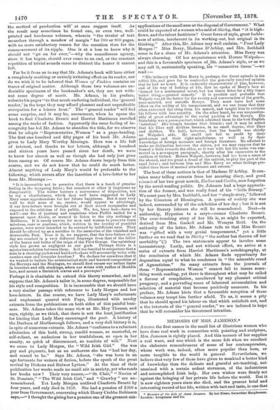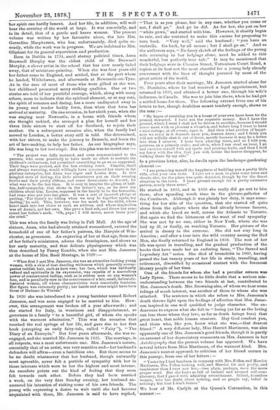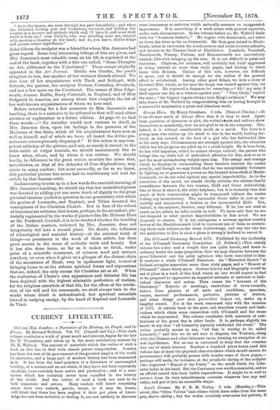MEMOIRS OF MRS. JAMESON.*
AMONG the first names in the small list of illustrious women who have done real work in connection with painting and sculpture, Mrs. Jameson is rightly placed. And this memoir of her supplies a real want, and one which is the more felt when we recollect the elaborate remembrances of some of her contemporaries, whose work was, indeed, often more popular than hers, or more tangible to the world in general. Nevertheless, we believe that very few of these have given to mankind a better kind of knowledge than the delicate and graceful art-teaching, not unmixed with a certain ardent sternness, of the industrious and accomplished Irish lady. Her own wishes were firmly set against the bringing of her private life before the world. But it is now eighteen years since she died, and the present brief and interesting record of her life, written with tact and taste, is one that • Memoirs of the Life of Anna Jameson. By her Niece, Clerardine Macpherson. London: Longmans and Co.
her spirit can hardly lament. And her life, in addition, will well bear the scrutiny of the world at large. It was essentially, and in its detail, that of a gentle and brave woman. The present volume was written by her favourite niece, the late Mrs. Gerardine Macpherson, who has, unfortunately, died quite re- cently, while the work was in progress. We are indebted to Mrs. Oliphant for its general supervision and production.
Born in Dublin in 1794, amid stormy political times, Anna Brownell Murphy was the eldest child of Mr. Brownell Murphy, a clever artist in the school that has now nearly failed away, that of miniature-painting. When she was four years old her father came to England, and settled, first at the port where he landed, Whitehaven, and afterwards at Newcastle-on-Tyne. As in the case of most of those who were gifted as she was, her childhood presented many striking qualities. One or two stories are told of her youthful courage, which, along with many others, seem to indicate that the spiritual element, or at any rate, the spirit of romance and daring, has a more undisputed sway in its young and tender bodily form, than when that form has arrived at maturity. On one occasion, in her ninth year, when she was staying near Newcastle, in a house with friends whom she thought unkind, she arranged a plan for herself and her three little sisters to start off for Scotland, to rejoin their mother. On a subsequent occasion also, when the family had moved to London, a better story still is told. She determined, with her sisters, to make the journey to Brussels, and learn the art of lace-making, to help her father. As our biographer says, life was long to her tout simple. But this plan was no secret one :— " Tho project was fully matured, and even communicated to the parents, who seem prudently to have made no effort to restrain the children's enthusiasm, but permitted everything to go on as suggested. Their bags were packed, and the last evening came. Camilla, timid and always wavering, would willingly have renounced her share in the glorious enterprise, but Anna was eager and Louisa firm. In this mingled state of feeling, the little adventurers put on their evening frocks and their pretty ribbons, and came down-stairs to dessert, for what was to be the last time. It is easy to imagine the gloam of half- fun, half-sympathy, that shone in the father's eye, as he drew the children about him. Louisa, supposed in the family to be the favourite, had some wine put into her glass. It was a sort of farewell pledge at parting, 'For there's no telling when we may be together again, my darling,' he said. This, however, was too much for the child, whose heart sank into her shoes at such an address, and whose inspiration was all Anna's, not her own. She gave a loud sob, and throw her arms round her father's neck. 'Oh, papa! I will never, never leave you!' she cried."
This was when the family was living in Pall Mall. At the age of sixteen, Anna, who had already attained womanhood, entered the household of one of her father's patrons, the Marquis of Win- chester, as governess. An engraving of her at that age, from one of her father's miniatures, adorns the frontispiece, and shows us her early maturity, and that delicate physiognomy which was thus described by Fanny Kemble, when she met Mrs. Jameson at the house of Mrs. Basil Montagu, in 1828 :—
" When first I met Mrs. Jameson, she was an attractive-looking young woman, with a skin of that dazzling whiteness which generally accom- panies reddish hair, such as hers was; her face, which was habitually refined and spirituelle in its expression, was capable of a marvellous power of concentrated feeling, such as is seldom seen on any woman's face, and is peculiarly rare in the countenance of a fair, small, delicately- featured woman, all whose characteristics were essentially feminine. Her figure was extremely pretty ; her hands and arms might have been those of Madame do Warens."
In 1820 she was introduced to a young barrister named Robert Jameson, and was soon engaged to be married to him. How- ever, this arrangement was broken off a year afterwards ; and she started for Italy, in weariness and disappointment, as governess in a family " to a beautiful girl, of whom she speaks with the warmest admiration." This was the occasion that touched the real springs of her life, and gave rise to her first book (excepting an early fairy-tale, called " Faizy "), " The Diary of an Ennuyee." But four years afterwards, she was re- engaged, and she married Mr. Jameson in 1825. The marriage, in all respects, was a most unfortunate one. Mrs. Jameson's nature, essentially that of an artist, was very sensitive and—her husband's defenders will affirm—even a fastidious one. But there seems to be no doubt whatsoever that her husband, though outwardly most agreeable, never felt a particle of sympathy with her in those interests which were to her the highest and most intense. An anecdote points out the kind of feeling that they soon felt towards each other. Before they had bean married a week, on the very first Sunday evening, her husband an- nounced his intention of visiting some of his own friends. The young wife expressing a desire to wait until she had become acquainted with them, Mr. Jameson is said to have replied, manner :— "That is as you please, but in any case, whether you come or not, I shall go." And go he did. As for her, she put on her "white gown," and started with him. However, it shortly began to rain, and she ventured to make this excuse for proposing to
turn back. "Very well," said the husband ; "you have an umbrella. Go back, by all means ; but I shall go on." And as the authoress says, " No fancy sketch of the feelings of the young wife returning to her lodgings alone, need be added to this wonderful, but perfectly true tale." It may be mentioned that their lodgings were in Cheuies Street, Tottenham Court Road, a region at its best not the most cheerful for a young lady already conversant with the lines of thought pursued by most of the great artists of the world.
Four years after their marriage, Mr. Jameson started alone for St. Dominica, where he had received a legal appointment, but returned in 1833, and obtained a better one, through his wife's influence, in Canada. She was to join him there, when he bad got a settled home for them. The following extract from one of his letters to her, though doubtless meant tenderly enough, shows us the man :—
" My hopes of receiving you in a bons() of your own have been for the present thwarted. I have not the requisite money. But I have the ground, which I trust I shall not be driven to sacrifice, because I should never meet with so pleasant a situation, and before long I trust to have a nice cottage, at all events, Upton it. And then what portion of happi- ness we enjoy in it depends upon you, dearest Anna; and I think you will not wilfully shut it out-of-doors, merely because it may be a better fate than I deserve. I have been planting trees, and as I told you, potatoes, on a princely scale; and often, when I can steal an hour, I go and exercise myself with my spade and pruning-knife, and then I feed my fancy with the idea that you will, before the leaves disappear, bo walking there by my side."
In a previous letter, also, he dwells upon the landscape-gardening
element :—
" I am promb-ing myself the happiness of building you a pretty little villa, after your own taste. I have set a man to plant some trees and shrubs also, for the place was quite denuded, though by far the finest situation in the town. I have ground enough for a pretty extensive garden, nearly three acres."
He started in 1833, and in 1836 she really did go out to Lim there, after spending much time in the picture-galleries of the Continent. Although it was plainly her duty, it says some- thing for her side of the question, that she started off quite alone from the sphere where she had already become famous, and which she loved so well, across the Atlantic to Toronto.
But again we find the bitterness of the want of real sympathy She was met by no one, either in New York, where she was laid up ill, or finally, on reaching Toronto. Her picture of the arrival is dreary in the extreme. She did not stay long in America ; and after a tour into the wild country among the Red Men, she finally returned to England in 1838. The rest of her life was spent in travelling, and the gradual production of the books that have made her an enduring fame, "The Sacred and Legendary Art" series. She died of bronchitis in 1860, having passed the last twenty years of her life in study, travelling, and retirement, diversified by occasional contact with the foremost literary people of her time.
One of the friends for whom she had a peculiar esteem was
Lady Byron. There seems to be little doubt that a serious mis- understanding between the two friends at last, contributed to
Mrs. Jameson's death. Mrs. Browning also, of whom we hear some tidings of much interest, was another of those to whom she was attache& The sentence in which she refers to Mrs. Jameson's death throws light upon the feelings of affection that Mrs. Jame- son inspired in one well qualified to judge character. She en-
deavours to express what she felt in " losing (as far as the loving can lose those whom they love, as far as death brings loss) that great heart, that noble human creature. May God comfort you, and those who, like you, know what she was,—that dearest friend !" A very different lady, Miss Harriet Martineau, was also apparently one of Mrs. Jameson's good friends, though it is partly on account of her depreciatory comments on Mrs. Jameson in her Autobiography that the present volume has appeared. We have several letters from Miss Martineau, of the warmest kind. Mrs. Jameson's nearest approach to criticism of her friend occurs in this passage, from one Of her letters Yesterday I had luncheon in company with Mrs. Follen and Harriet Martineau, Mrs. Felton looking well, and Harriet fat and portly, and handsomer than I over saw her,—less plain, perhaps, were the more proper word. But she looks so full of radiant and assured self-com- placency, that I gazed with admiring astonishment. Gifted, dauntless women, who has doubt about nothing, and as people say, belief in nothing; but that I don't believe."
We hear of Mr. Carlyle at the Queen's Coronation, in this
" As to the Queen, she went through her part beautifully ; and when she returned, looking pale and tremulous, crowned, and holding her sceptre in a manner and attitude which said, '1 hare it, and none shall wrest it from me!' even Carlyle, who was standing near me, uttered with emotion a blessing on her head ; and he, you know, thinks kings and queens rather superfluous."
John Gibson the sculptor was a friend for whom Mrs. Jameson had great regard. Some very interesting tidings of him are given, and Mrs. Jameson's most valuable essay on his life is reprinted at the
end of the book, together with a fine one called, " Some Thoughts on Art, addressed to the Uninitiated." These essays originally appeared in the Art Journal. Ottilie von Goethe, the poet's
daughter-in-law, was another of her warmest friends abroad. We also hear of her acquaintance with Tieck and Schlegel, with Retzsch, the painter, the sculptor Powers, Cornelius, Overbeck, and not a few more on the Continent. The names of Miss Edge- worth, Joanna Baillie, Barry Cornwall, in England, and of Miss Sedgwick in America, are among those that complete the list of her well-known acquaintances of whom we here read.
Before reverting for a few moments to Mrs. Jameson's art- teaching, there is a sentence to be referred to that will need either excision or explanation in a future edition. At page 88 we find these words :—" No traveller would now venture to dwell, as Mrs. Jameson does, upon his feelings in the presence of the Madonna of San Sisto, which all his acquaintances have seen as well as himself, and of which we have all heard the divine pre- eminence contemptuously disparaged." If this refers to any com- petent criticism of the picture, and not, as surely it cannot, to the tittle-tattle of vulgar tourists, we should uncommonly like to know when, where, and by whom it was written. We should hardly, in deference to the great writer, mention the name that, nevertheless, as that of the defender of Prae-Raphaelitism, may occur to many readers ; but most assuredly, as far as we know, this particular picture has never had its traditionary veil rent for awhile by that famous critic.
Endeavouring to sum up in a few words the essential meaning of
Mrs. Jameson's teaching, we should say that her undoubted power was devoted to adding yet one more touch of dignity to the great pictorial idealism (called in question in our generation) with which the genius of Leonardo, and Raphael, and Titian invested the conceptions of the Christian Church. But in face of the school of historical art criticism that is now, perhaps, in the ascendent, pic- torially represented by the works of painters like Mr. Holman Hunt or Mr. Frederick Goodall, it is to be doubted whether the teaching of the Italian masters, endorsed by Mrs. Jameson, does not temporarily fall into a second place. No doubt, the influence of ethnological and material history—of the external truth of things—so prominent in the work of these artists, has done good service in the cause of aesthetic truth and beauty. But it has also done harm, so far as it makes us think, under guise of a scientific treatment, of crimson woof and antique jewellery, or even when it gives us a glimpse of the distant chain of the mountains of Moab, rosy in opalescent light, instead of bringing home to us the solemn spiritual forms and expressions
that are, indeed, the only excuse for Christian art at all. When the realisation of Christ's own appearance and Oriental life has been depicted with the highest attainable perfection of realism, for the religious essentials of that life, for the effect of the revela- tion of his will and his commands, we shall always turn to the works where detail is subordinated, but spiritual essentials limned in undying energy, by the hand of Raphael and Leonardo da Vinci.




































 Previous page
Previous page